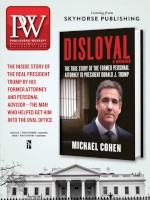In the alternate 19th century of Alix E. Harrow’s second novel, The Once and Future Witches (Redhook, Oct.), the reemergence of witchcraft reunites three estranged sisters in New Salem, Mass., and alters the course of the suffragist movement. Harrow, a 2019 Hugo Award winner for the short story “A Witch’s Guide to Escape,” deploys fairy tales and feminist thought in a novel PW’s review called “gleefully referential; folklore and history enthusiasts will have a feast.” She spoke with PW about why witches might just be the heroes modern times demand.
What’s your approach to crafting a fictional universe?
I’ve never done as much worldbuilding before as I have for this novel. Normally my writing takes places in a more recognizable version of our world; here I had to imagine what it would mean if witchcraft actually existed. How would it have changed history? As a rule, I use the idea that “history doesn’t repeat, but it rhymes.” History would be different, but there would still be elements that are recognizable.
How has your background as a historian informed your writing?
It’s easy to get sucked into historiographical arguments about witchcraft or suffragism, but that can narrow your vision. Fiction allows you to fudge the details a bit, so that I could imagine a women’s movement where credit was given to those who aren’t as famous, or where diverse voices can be more widely acknowledged.
How did you do this in the novel?
If we imagine a world where magic exists as an elemental language, it’s silly to pretend that different cultures would be using the same terms—each culture would develop its own. In imagining an alternate history of the women’s movement, while giving credit to the actual diversity of the suffragettes I based my characters on, I wanted that sort of diversity represented, even in a novel about witchcraft. We can suspend our disbelief about magic in a novel, but our reality should still be reflected.
Why did you incorporate fairy tales into the narrative?
They’re a good way for us to understand how it is that people cling to stories, and they help me to describe the differences between the real world and the fictional one in the novel. One thing that I’m aware of, however, is that Western fairy tales aren’t universal. In graduate school we discussed how much the Western perspective has shaped what we read, so that nothing is exactly objective. This became important in the novel when I incorporated different sorts of fairy tales, from different cultures.
What do you think is behind the recent resurgence of stories about witches?
People are comfortable with men who practice magic in novels: the wise, old wizard who gets the ring. But women depicted as witches are these infertile people who live in the woods and curse crops. Some recent novels are about reclaiming what’s subversive and challenging about witches. I don’t want to claim that everything is related to the #MeToo movement, or the Women’s March, but there’s a new urgency to bring things to light and to speak our stories. Being a female-presenting person has a way of making you angrier as you confront unfair things. In that way, I think that witchcraft helps to supply a language of power and resistance.



 Volume 267
Issue 36
09/07/2020
Volume 267
Issue 36
09/07/2020





